isofix RENAULT TWINGO 2012 2.G Owners Manual
[x] Cancel search | Manufacturer: RENAULT, Model Year: 2012, Model line: TWINGO, Model: RENAULT TWINGO 2012 2.GPages: 220, PDF Size: 6.73 MB
Page 32 of 220
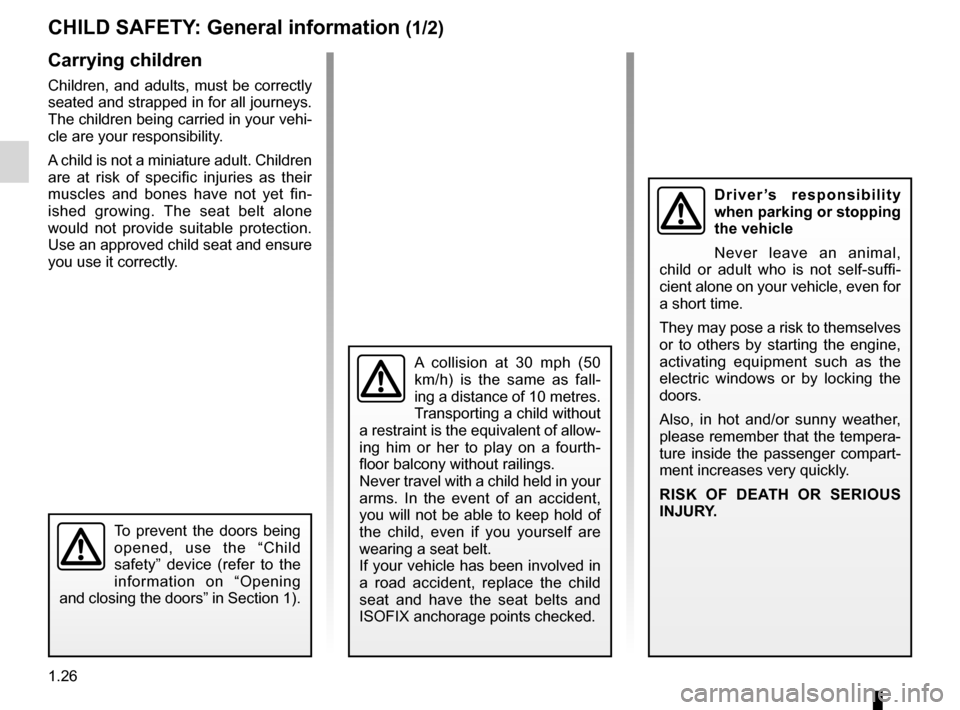
child safety............................................ (up to the end of the DU)
child restraint/seat ................................ (up to the end of the DU)
child restraint/seat ................................ (up to the end of the DU)
child restraint/seat ................................ (up to the end of the DU)
child seats ............................................. (up to the end of the DU)
transporting children ............................. (up to the end of the DU)
children ................................................. (up to the end of the DU)
1.26
ENG_UD20118_2
Sécurité enfants : généralités (X44 - Renault)
ENG_NU_952-4_X44_Renault_1
Jaune NoirNoir texte
Carrying children
Children, and adults, must be correctly
seated and strapped in for all journeys.
The children being carried in your vehi-
cle are your responsibility.
A child is not a miniature adult. Children
are at risk of specific injuries as their
muscles and bones have not yet fin -
ished growing. The seat belt alone
would not provide suitable protection.
Use an approved child seat and ensure
you use it correctly.
Child safety: General information
ChILD sAFETY : General information (1/2)
To prevent the doors being
opened, use the “Child
safety” device (refer to the
information on “Opening
and closing the doors” in Section 1).
A collision at 30 mph (50
km/h) is the same as fall -
ing a distance of 10 metres.
Transporting a child without
a restraint is the equivalent of allow-
ing him or her to play on a fourth -
floor balcony without railings.
Never travel with a child held in your
arms. In the event of an accident,
you will not be able to keep hold of
the child, even if you yourself are
wearing a seat belt.
If your vehicle has been involved in
a road accident, replace the child
seat and have the seat belts and
ISOFIX anchorage points checked.
D r i v e r ’s r e s p o n s i b i l i t y
when parking or stopping
the vehicle
Never leave an animal,
child or adult who is not self-suffi -
cient alone on your vehicle, even for
a short time.
They may pose a risk to themselves
or to others by starting the engine,
activating equipment such as the
electric windows or by locking the
doors.
Also, in hot and/or sunny weather,
please remember that the tempera-
ture inside the passenger compart-
ment increases very quickly.
RI sK OF DEAT h OR sERIOU s
INJURY.
Page 35 of 220
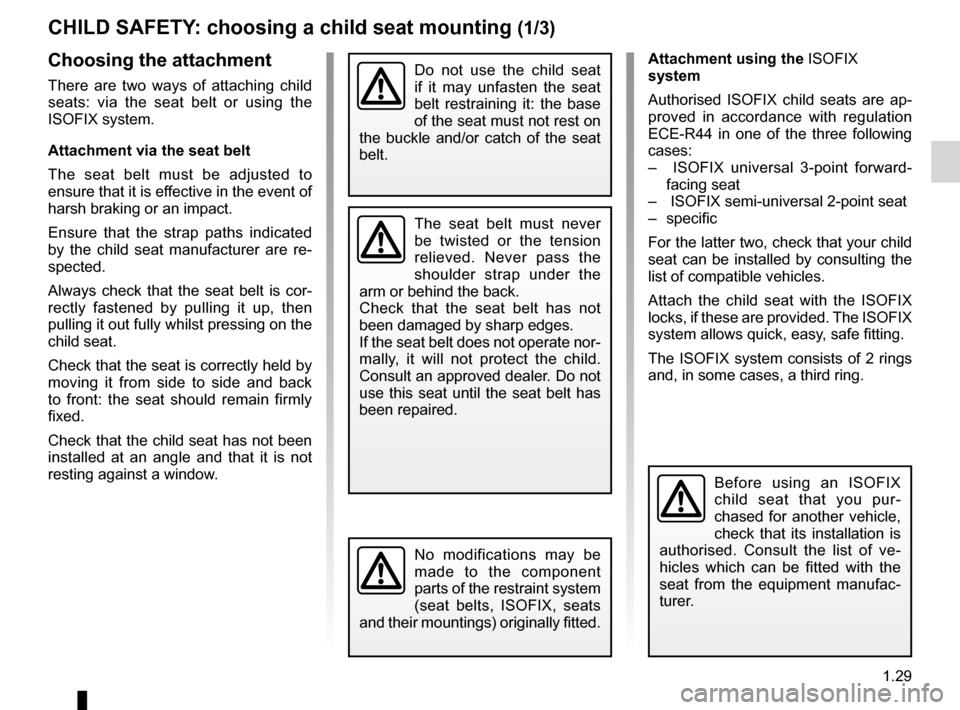
child safety............................................ (up to the end of the DU)
child restraint/seat ................................ (up to the end of the DU)
child restraint/seat ................................ (up to the end of the DU)
child restraint/seat ................................ (up to the end of the DU)
child seats ............................................. (up to the end of the DU)
transporting children ............................. (up to the end of the DU)
1.29
ENG_UD24374_5
Sécurité enfants : choix de la fixation du siège enfant (X44 \
- Renault)
ENG_NU_952-4_X44_Renault_1
Choosing a child seat mounting
ChILD sAFETY : choosing a child seat mounting (1/3)
Choosing the attachment
There are two ways of attaching child
seats: via the seat belt or using the
ISOFIX system.
Attachment via the seat belt
The seat belt must be adjusted to
ensure that it is effective in the event of
harsh braking or an impact.
Ensure that the strap paths indicated
by the child seat manufacturer are re -
spected.
Always check that the seat belt is cor-
rectly fastened by pulling it up, then
pulling it out fully whilst pressing on the
child seat.
Check that the seat is correctly held by
moving it from side to side and back
to front: the seat should remain firmly
fixed.
Check that the child seat has not been
installed at an angle and that it is not
resting against a window.
Attachment using the ISOFIX
system
Authorised ISOFIX child seats are ap -
proved in accordance with regulation
ECE-R44 in one of the three following
cases:
– ISOFIX universal 3-point forward -
facing seat
– ISOFIX semi-universal 2-point seat
– specific
For the latter two, check that your child
seat can be installed by consulting the
list of compatible vehicles.
Attach the child seat with the ISOFIX
locks, if these are provided. The ISOFIX
system allows quick, easy, safe fitting.
The ISOFIX system consists of 2 rings
and, in some cases, a third ring.
Before using an ISOFIX
child seat that you pur -
chased for another vehicle,
check that its installation is
authorised. Consult the list of ve -
hicles which can be fitted with the
seat from the equipment manufac -
turer.
The seat belt must never
be twisted or the tension
relieved. Never pass the
shoulder strap under the
arm or behind the back.
Check that the seat belt has not
been damaged by sharp edges.
If the seat belt does not operate nor-
mally, it will not protect the child.
Consult an approved dealer. Do not
use this seat until the seat belt has
been repaired.
Do not use the child seat
if it may unfasten the seat
belt restraining it: the base
of the seat must not rest on
the buckle and/or catch of the seat
belt.
No modifications may be
made to the component
parts of the restraint system
(seat belts, ISOFIX, seats
and their mountings) originally fitted.
Page 36 of 220
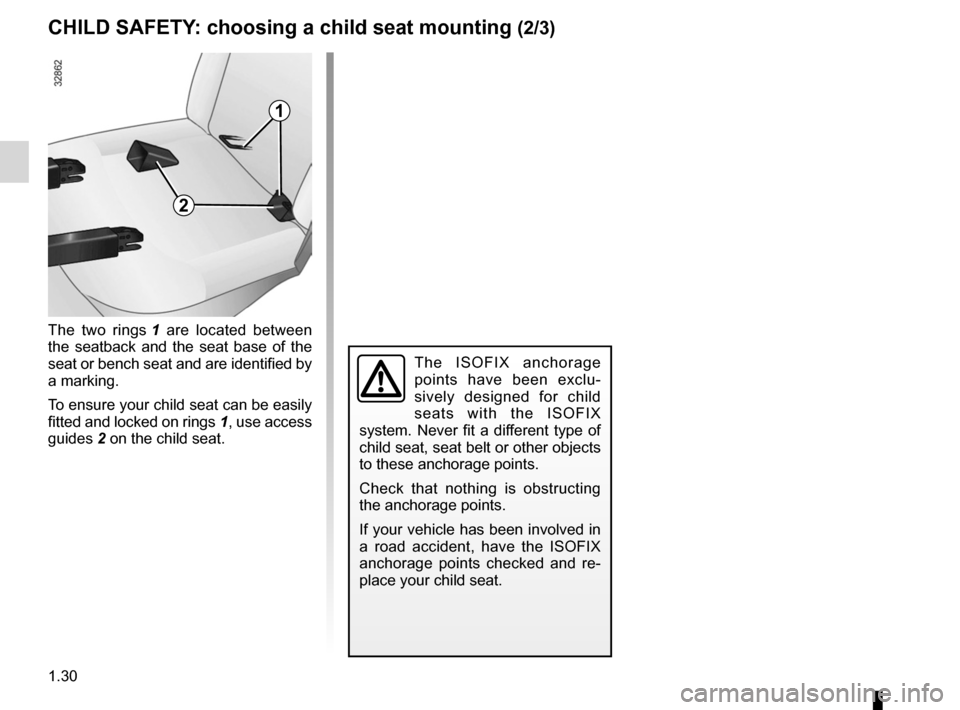
1.30
ENG_UD24374_5
Sécurité enfants : choix de la fixation du siège enfant (X44 \
- Renault)
ENG_NU_952-4_X44_Renault_1
Jaune NoirNoir texte
The two rings 1 are located between
the seatback and the seat base of the
seat or bench seat and are identified by
a marking.
To ensure your child seat can be easily
fitted and locked on rings 1, use access
guides 2 on the child seat.
The ISOFIX anchorage
points have been exclu -
sively designed for child
seats with the ISOFIX
system. Never fit a different type of
child seat, seat belt or other objects
to these anchorage points.
Check that nothing is obstructing
the anchorage points.
If your vehicle has been involved in
a road accident, have the ISOFIX
anchorage points checked and re -
place your child seat.
ChILD sAFETY : choosing a child seat mounting (2/3)
1
2
Page 37 of 220
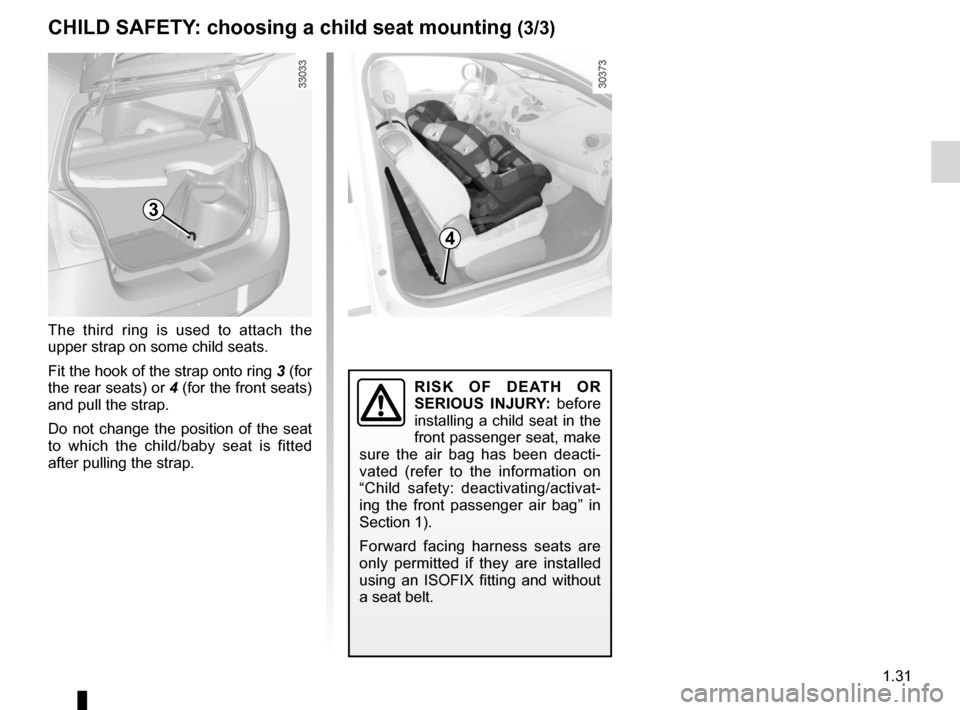
JauneNoirNoir texte
1.31
ENG_UD24374_5
Sécurité enfants : choix de la fixation du siège enfant (X44 \
- Renault)
ENG_NU_952-4_X44_Renault_1
The third ring is used to attach the
upper strap on some child seats.
Fit the hook of the strap onto ring 3 (for
the rear seats) or 4 (for the front seats)
and pull the strap.
Do not change the position of the seat
to which the child/baby seat is fitted
after pulling the strap.
R I sK O F D E AT h O R
s ERIOU s INJURY: before
installing a child seat in the
front passenger seat, make
sure the air bag has been deacti -
vated (refer to the information on
“Child safety: deactivating/activat -
ing the front passenger air bag” in
Section 1).
Forward facing harness seats are
only permitted if they are installed
using an ISOFIX fitting and without
a seat belt.
ChILD sAFETY : choosing a child seat mounting (3/3)
4
3
Page 38 of 220
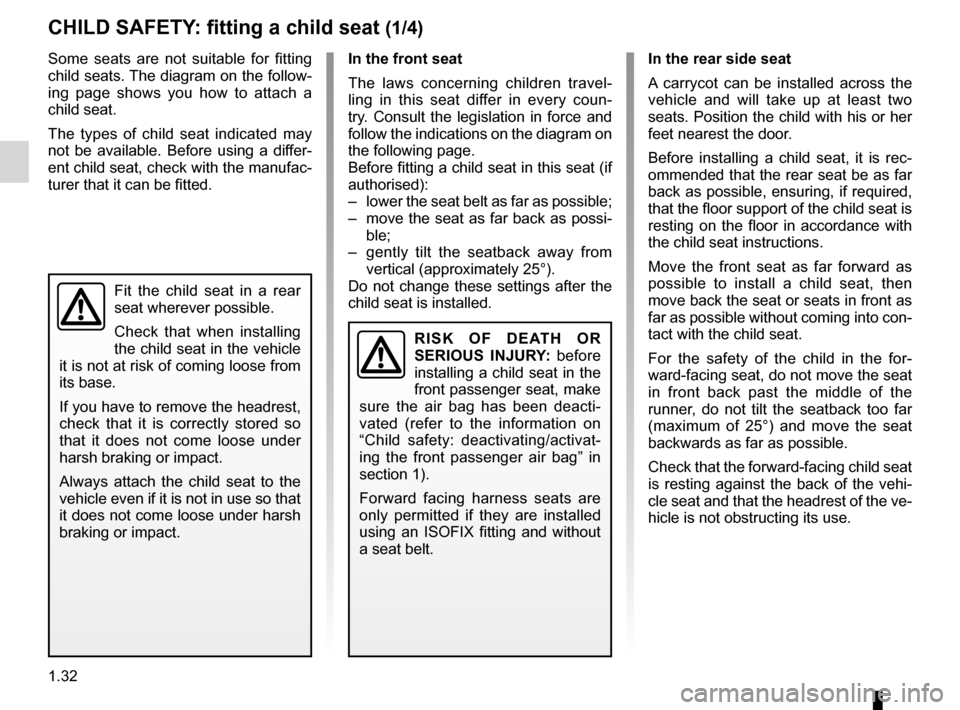
child safety............................................ (up to the end of the DU)
child restraint/seat ................................ (up to the end of the DU)
child restraint/seat ................................ (up to the end of the DU)
child seats ............................................. (up to the end of the DU)
child restraint/seat ................................ (up to the end of the DU)
transporting children ............................. (up to the end of the DU)
1.32
ENG_UD24497_2
Sécurité enfants : installation du siège enfant (X44 - Renault\
)
ENG_NU_952-4_X44_Renault_1
Jaune NoirNoir texte
Fitting a child seat
Some seats are not suitable for fitting
child seats. The diagram on the follow -
ing page shows you how to attach a
child seat.
The types of child seat indicated may
not be available. Before using a differ-
ent child seat, check with the manufac-
turer that it can be fitted.
Fit the child seat in a rear
seat wherever possible.
Check that when installing
the child seat in the vehicle
it is not at risk of coming loose from
its base.
If you have to remove the headrest,
check that it is correctly stored so
that it does not come loose under
harsh braking or impact.
Always attach the child seat to the
vehicle even if it is not in use so that
it does not come loose under harsh
braking or impact.
In the front seat
The laws concerning children travel -
ling in this seat differ in every coun -
try. Consult the legislation in force and
follow the indications on the diagram on
the following page.
Before fitting a child seat in this seat (if
authorised):
– lower the seat belt as far as possible;
– move the seat as far back as possi-
ble;
– gently tilt the seatback away from
vertical (approximately 25°).
Do not change these settings after the
child seat is installed.
R I sK O F D E AT h O R
s ERIOU s INJURY: before
installing a child seat in the
front passenger seat, make
sure the air bag has been deacti -
vated (refer to the information on
“Child safety: deactivating/activat -
ing the front passenger air bag” in
section 1).
Forward facing harness seats are
only permitted if they are installed
using an ISOFIX fitting and without
a seat belt.
In the rear side seat
A carrycot can be installed across the
vehicle and will take up at least two
seats. Position the child with his or her
feet nearest the door.
Before installing a child seat, it is rec -
ommended that the rear seat be as far
back as possible, ensuring, if required,
that the floor support of the child seat is
resting on the floor in accordance with
the child seat instructions.
Move the front seat as far forward as
possible to install a child seat, then
move back the seat or seats in front as
far as possible without coming into con-
tact with the child seat.
For the safety of the child in the for -
ward-facing seat, do not move the seat
in front back past the middle of the
runner, do not tilt the seatback too far
(maximum of 25°) and move the seat
backwards as far as possible.
Check that the forward-facing child seat
is resting against the back of the vehi-
cle seat and that the headrest of the ve-
hicle is not obstructing its use.
ChILD sAFETY : fitting a child seat (1/4)
Page 39 of 220
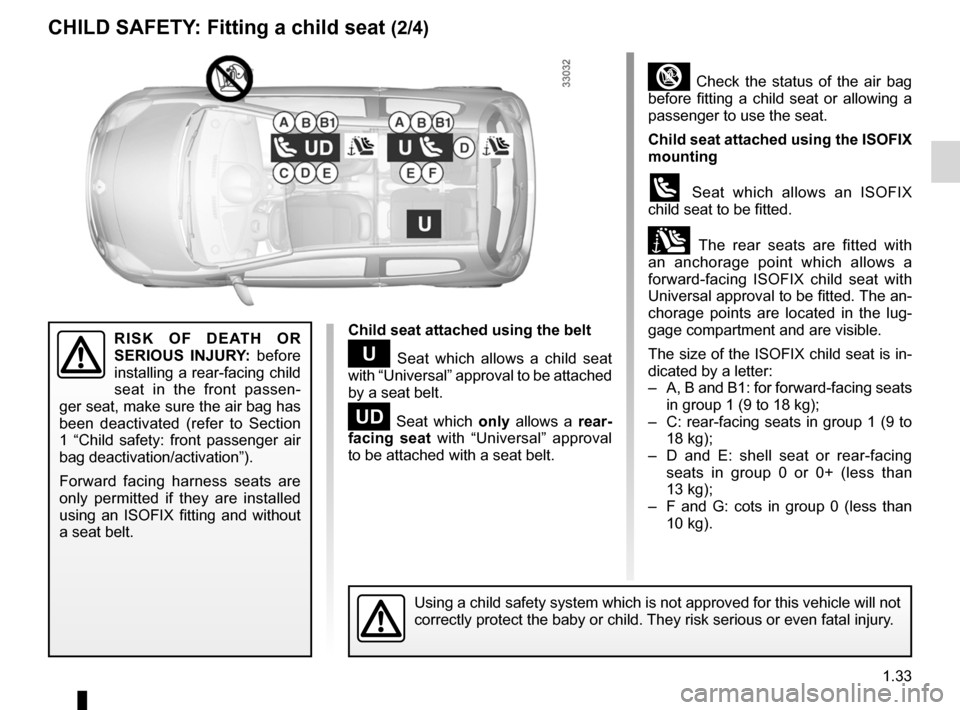
JauneNoirNoir texte
1.33
ENG_UD24497_2
Sécurité enfants : installation du siège enfant (X44 - Renault\
)
ENG_NU_952-4_X44_Renault_1
ChILD sAFETY : Fitting a child seat (2/4)
R IsK O F D E AT h O R
s ERIOU s INJURY: before
installing a rear-facing child
seat in the front passen -
ger seat, make sure the air bag has
been deactivated (refer to Section
1 “Child safety: front passenger air
bag deactivation/activation”).
Forward facing harness seats are
only permitted if they are installed
using an ISOFIX fitting and without
a seat belt.Child seat attached using the belt
¬ Seat which allows a child seat
with “Universal” approval to be attached
by a seat belt.
− Seat which only allows a rear-
facing seat with “Universal” approval
to be attached with a seat belt.
³ Check the status of the air bag
before fitting a child seat or allowing a
passenger to use the seat.
Child seat attached using the IsOFIX
mounting
ü Seat which allows an ISOFIX
child seat to be fitted.
± The rear seats are fitted with
an anchorage point which allows a
forward-facing ISOFIX child seat with
Universal approval to be fitted. The an-
chorage points are located in the lug -
gage compartment and are visible.
The size of the ISOFIX child seat is in-
dicated by a letter:
– A, B and B1: for forward-facing seats
in group 1 (9 to 18 kg);
– C: rear-facing seats in group 1 (9 to
18 kg);
– D and E: shell seat or rear-facing
seats in group 0 or 0+ (less than
13 kg);
– F and G: cots in group 0 (less than
10 kg).
Using a child safety system which is not approved for this vehicle will not
correctly protect the baby or child. They risk serious or even fatal injury.
Page 40 of 220
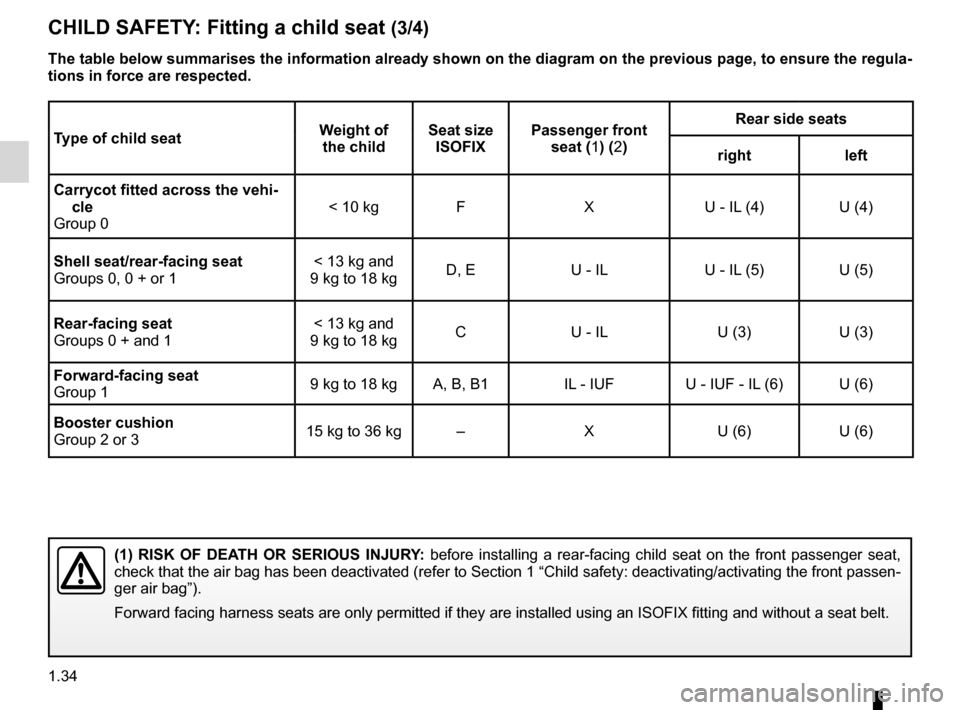
1.34
ENG_UD24497_2
Sécurité enfants : installation du siège enfant (X44 - Renault\
)
ENG_NU_952-4_X44_Renault_1
Jaune NoirNoir texte
Type of child seat Weight of
the child seat size
IsOFIX passenger front
seat (1) (2) Rear side seats
right left
Carrycot fitted across the vehi- cle
Group 0 < 10 kg
F XU - IL (4) U (4)
shell seat/rear-facing seat
Groups 0, 0 + or 1 < 13 kg and
9 kg to 18 kg D, E
U - IL U - IL (5) U (5)
Rear-facing seat
Groups 0 + and 1 < 13 kg and
9 kg to 18 kg C
U - IL U (3)U (3)
Forward-facing seat
Group 1 9 kg to 18 kg
A, B, B1 IL - IUFU - IUF - IL (6) U (6)
Booster cushion
Group 2 or 3 15 kg to 36 kg
–X U (6)U (6)
(1) RIsK OF DEATh OR sERIOUs INJURY: before installing a rear-facing child seat on the front passenger seat,
check that the air bag has been deactivated (refer to Section 1 “Child safety: deactivating/activating the front passen -
ger air bag”).
Forward facing harness seats are only permitted if they are installed us\
ing an ISOFIX fitting and without a seat belt.
ChILD sAFETY : Fitting a child seat (3/4)
The table below summarises the information already shown on the diagram on the previous page, to ensure the regula-
tions in force are respected.
Page 41 of 220
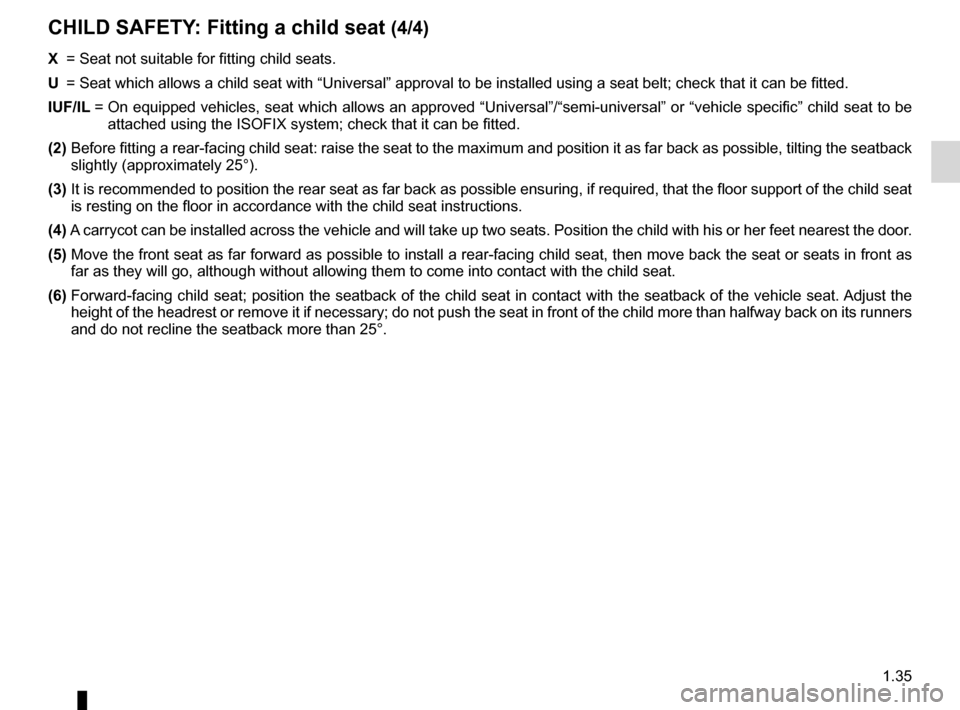
JauneNoirNoir texte
1.35
ENG_UD24497_2
Sécurité enfants : installation du siège enfant (X44 - Renault\
)
ENG_NU_952-4_X44_Renault_1
X = Seat not suitable for fitting child seats.
U = Seat which allows a child seat with “Universal” approval to be installed using a seat belt; check that it can be fitted.
IUF/IL = On equipped vehicles, seat which allows an approved “Universal”/“semi-universal” or “vehicle specific” child seat to be
attached using the ISOFIX system; check that it can be fitted.
(2) Before fitting a rear-facing child seat: raise the seat to the maximum and position it as far back as possible, tilting the seatback
slightly (approximately 25°).
(3) It is recommended to position the rear seat as far back as possible ensuring, if required, that the floor support of the child seat
is resting on the floor in accordance with the child seat instructions.
(4) A carrycot can be installed across the vehicle and will take up two seats. Position the child with his or her feet nearest the door.
(5) Move the front seat as far forward as possible to install a rear-facing child seat, then move back the seat or seats in front as
far as they will go, although without allowing them to come into contact\
with the child seat.
(6) Forward-facing child seat; position the seatback of the child seat in contact with the seatback of the vehicle seat. Adjust the
height of the headrest or remove it if necessary; do not push the seat in front of the child more than halfway back on its runners
and do not recline the seatback more than 25°.
ChILD sAFETY : Fitting a child seat (4/4)